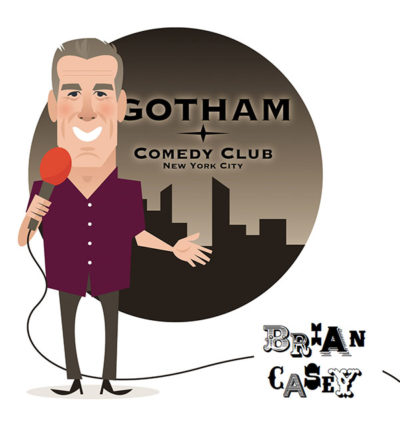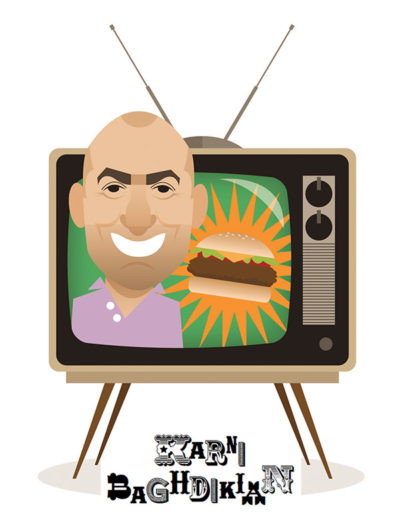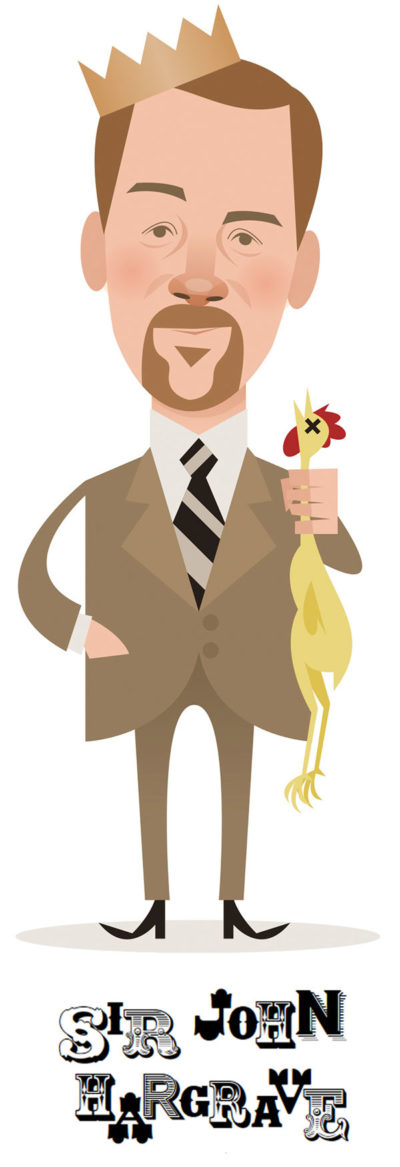
Sir John Hargrave, MBA’04, doesn’t look like a troublemaker. Sporting glasses, a sweater, and a button-down shirt, he looks more like an accountant preparing your taxes.
Spend time with Hargrave, though, and you may feel a bit anxious, wondering if a whoopee cushion waits on your seat or if a bucket of water is about to pour on your head.
Hargrave is a professional prankster. Born fittingly on April Fools’ Day, he has written two books on pranks and made a career out of stunts and tomfoolery. Ranging from the sublime to the silly, his pranks have landed him on the front pages of newspapers, and they have landed him in jail. He has shouted, “Can you hear me now?” into a megaphone outside the house of Verizon’s CEO. He has called a Chinese restaurant to complain about the fortune in a fortune cookie. He has covered an unsuspecting woman’s cubicle in hundreds of waffles. He has chased an accomplice dressed as Twitter’s bird mascot through a conference hall as the CEO of Twitter was set to speak. He even has changed his name legally, adding a “sir” to poke fun at the stodginess of the royal family.
Hargrave insists this mischief is all in good fun. “At the end of the day, everyone should be laughing, including the person who was pranked,” says Hargrave, CEO and founder of Media Shower, a Sherborn, Mass., company that creates offbeat and humorous content for websites. “Pranks are a way of waking everyone up. We as a society have a need for pranks. They make us look at an ordinary situation in a different way.”
Good pranks also should be funny. Check out Hargrave’s antics, and you’ll laugh a lot, which is a credit to the prankster. Making people laugh is a hard business, and it doesn’t always pay the bills. But being funny has power, whether one is pulling pranks, making videos, or telling jokes on stage. Humor can sell a product, humble the mighty, make you think, and lighten your load, at least for a little while.
Diet Cokes and a Dirty Secret
How hard is being funny? Consider standup comedy. Many people are funny in their everyday lives with friends, says Brian Casey ’77, but climbing on stage and entertaining strangers is a whole other matter.
 Casey performs stand-up from time to time, whenever he’s feeling the itch. He admits he’s “not good enough” to make it a career, but he has performed in a number of clubs, including the famed Gotham Comedy Club in New York City. “It was a thrill,” he says. Casey started performing when a friend talked him into taking a stand-up comedy class together at the Boston Center for Adult Education. The friend chickened out at the last minute, but Casey went ahead anyway and soon was hooked.
Casey performs stand-up from time to time, whenever he’s feeling the itch. He admits he’s “not good enough” to make it a career, but he has performed in a number of clubs, including the famed Gotham Comedy Club in New York City. “It was a thrill,” he says. Casey started performing when a friend talked him into taking a stand-up comedy class together at the Boston Center for Adult Education. The friend chickened out at the last minute, but Casey went ahead anyway and soon was hooked.
For the comedians who aren’t headliners, a typical slot at a club may be seven minutes, Casey says. That might not sound like much, but those seven minutes need to be tight, smart, and well-rehearsed. “Everything is calculated,” says Casey, who when not on stage is the marketing manager at SmartDrive Systems, a San Diego company that makes software to help vehicle fleets reduce carbon emissions and save fuel. “You work on jokes a long time. You do it in your head constantly.”
Casey’s material leans toward observational humor, and he keeps a recorder in his car so he can take down joke ideas when they strike him. “You write a whole bunch of stuff; you throw away a bunch of stuff,” he says. When crafting his set, he mulls over which individual words to use. “What’s funnier,” he’ll think, “big, large, or enormous?” Even throwaway comments, a “huh” or “yeah,” are in the set on purpose to give emphasis or a pause. Nothing is improvised, even if it seems that way. “The dirty secret of stand-up comedy is it’s all about memorization,” Casey says.
Once his set is ready and Casey—fueled by lots of Diet Cokes—climbs onstage, one of the biggest challenges he faces is distracted audiences. Casey often plays open mic nights, when the club is filled with jittery amateur comedians too busy fretting and reading their notes to laugh at his jokes. “There is a little pool of nervousness,” he says. To grab people’s attention, he’ll sometimes walk into the audience and poke fun at folks (“You can do better,” he’ll say to one of a couple.).
No matter how hard he has worked on a set, there’s no guarantee it’ll set off gut-busting belly laughs. “Everybody bombs on stage on a regular basis,” he says. “You expect it to happen.” Inexplicably, the same material that went well one week may land with a thud the next. For those moments, Casey can only shake it off and hop on stage again. “There’s always tomorrow night,” he says.
And the next night can be magic. Casey may connect with the audience, laughs may come easy and often, and he’ll think to himself, “This is the way life should be.”
And the Savings Ran Out
Stand-up’s challenges don’t end with the grind of creating sets and the fickleness of scoring laughs. Comedians also must find stage time, an audience, and someone who will actually pay them.
 Babson’s Lakshmi Balachandra knows about these frustrations all too well. The assistant professor of entrepreneurship has experienced a wide-ranging career, one with twists and turns that sent her bouncing between coasts, jobs, and passions. Her resume includes stints launching a toy store, working in venture capital, and teaching in academia. For many years, she also pursued something daring and different, not to mention difficult.
Babson’s Lakshmi Balachandra knows about these frustrations all too well. The assistant professor of entrepreneurship has experienced a wide-ranging career, one with twists and turns that sent her bouncing between coasts, jobs, and passions. Her resume includes stints launching a toy store, working in venture capital, and teaching in academia. For many years, she also pursued something daring and different, not to mention difficult.
Having grown up watching and adoring Saturday Night Live, Balachandra always had an interest in trying her hand at comedy. While working at a toy store in San Diego after college, she took lessons in improvisational comedy and joined an improv troupe. Working without a script and following the shouted-out suggestions from audiences, she learned to build scenes and flesh out characters, to listen intently to her fellow performers, and to focus. “You have to be in the moment,” she says. “It’s incredibly terrifying.”
But it also proved exhilarating. Tiring of the toy store, Balachandra returned to the Boston area, where she grew up, and went to work in venture capital. While she couldn’t find the right improv group to join, she continued in comedy by taking a stand-up comedy class, just as Casey did, at the Boston Center for Adult Education. The class ended with the students participating in a “Sacrificing Virgins” show at a Harvard Square comedy club. Balachandra loved it. Telling jokes about dating, politics, men, and being Indian, she began performing at open mic nights and as a warm-up for bigger acts.
Stand-up isn’t a lucrative line of work. At a gig, she might receive a free drink or two, and one club paid her all of $10 for a show. Yet she still wondered about standup as a career. With no husband, children, or mortgage tying her down, and having had her applications to three MBA schools recently rejected, she decided to move to L.A. to pursue stand-up full time. She even turned down an enticing offer to join a women-focused venture capital firm before she left. “If I don’t do this now,” she thought, “I never will.”
Compared to Boston, L.A.’s comedy scene was bigger and more intimidating. Boston had only a handful of comedy venues; L.A. had about 200, and they were loaded with fledgling comedians struggling to have their jokes heard. “The competition is huge,” Balachandra says. “It’s impossible to get stage time.” Many clubs had what are called “bringer” shows, which give comedians time to perform only if they bring along a number of cover-paying customers.
Although Balachandra used her comedy connections from Boston to land stage time and avoid the disheartening bringer shows, her comedic aspirations remained stalled. Her act was improving, but she was never paid for her performances, and she often appeared in nearly empty venues. “There’s no guarantee you’ll have an audience,” she says. Soon her savings ran out, and Balachandra realized that years of struggle waited for her if she stayed in L.A. After about eight months, she returned to Massachusetts, where the position at the women-focused venture capital firm was still available.
Balachandra eventually went on to earn an MBA and then a PhD. Today, her Blank Center office looks like any other professor’s on campus, with its family pictures, books, and wall covered in IdeaPaint. Nothing hints at her former life full of nervous nights and two-drink minimums. “Obviously, I didn’t make it in stand-up,” she says. “I’m glad I did it. It’s out of my system. I have no interest in doing standup ever again.”
Not that she has entirely left her old comedy days behind. The ability to adapt and think on your feet, so important in comedic improvisation, also is critical to business, Balachandra says. She taught a course on improvisational leadership at MIT’s Sloan School of Management, and she teaches improvisation in negotiations at Harvard Business School. At Babson, she hopes to develop a class on improvisation for entrepreneurs.
Rocky Wants a Cheesesteak Burger
Karni Baghdikian ’99 strives to make people laugh, not on stage, but on the screen. Living in the L.A. area, he’s a filmmaker who serves as a director, writer, and producer of commercials and short films. Comedy is an important filmmaking tool for Baghdikian. It can break tension, reveal character, and change the pace, though his efforts are at the mercy of the actors. A great actor can make a humorous script even funnier, or find the comedy hidden in the lines that a director didn’t know was there. “The right casting can make or break it,” he says.
 Baghdikian’s first brush with movie magic was as an extra in Scent of a Woman during high school. He cut school for three days and was paid $300. “I take no credit for the Academy Award for Al Pacino,” he says. After graduating from Babson, he worked in advertising for years, creating websites and ads and producing campaigns, but he yearned for a change. “It became increasingly clear that the thing I really, really wanted to do most with my life was write and direct,” he says. Deciding not to attend film school, and opting instead for real-world experience, he learned about directing as part of a filmmaking coop called Annex Film Group. He became a full-time filmmaker in 2009, and his ultimate goal is to direct Hollywood films. “It’s a long, slow road,” Baghdikian says. “I consider myself an apprentice for life.”
Baghdikian’s first brush with movie magic was as an extra in Scent of a Woman during high school. He cut school for three days and was paid $300. “I take no credit for the Academy Award for Al Pacino,” he says. After graduating from Babson, he worked in advertising for years, creating websites and ads and producing campaigns, but he yearned for a change. “It became increasingly clear that the thing I really, really wanted to do most with my life was write and direct,” he says. Deciding not to attend film school, and opting instead for real-world experience, he learned about directing as part of a filmmaking coop called Annex Film Group. He became a full-time filmmaker in 2009, and his ultimate goal is to direct Hollywood films. “It’s a long, slow road,” Baghdikian says. “I consider myself an apprentice for life.”
A few words come to mind when describing Baghdikian’s style. Whimsical is one. Boyish, fun, and witty are others. His spots for the Philly Cheesesteak Burger from Carl’s Jr. feature stop-motion animation set in a world full of Lego-style construction blocks. In the ads, a mumbling Rocky Balboa, grumpy Founding Fathers, and a ferocious monster all need their hunger satiated. Baghdikian also has done spots for Visine eye drops, which are now airing nationally, and Hasbro’s KRE-O building blocks, in which Transformer robots compete in dance competitions and open up Christmas presents in their bathrobes and slippers.
“I enjoy quirky comedy,” says Baghdikian. Think of friends you can hang out with for hours, just making fun of what’s on TV and cracking each other up with jokes and inside humor. This is the vibe Baghdikian wants in his ads and films. “I enjoy the kind of joking around you would do with your buddies,” he says. When he puts together a portfolio of his work, he wants this jocular feel to shine through and distinguish him from other filmmakers.
When Carl’s Jr. was looking for a filmmaker to work with, it needed someone who could reach 18- to 25-year-olds. As Baghdikian puts it, there are two ways to target that audience: “You get them with good buddy comedy and with girls in bikinis.” Baghdikian didn’t have to resort to swimwear; his work’s funny voice and personality were exactly what Carl’s Jr. wanted.
300 Pounds of Sand
For Sir John Hargrave the prankster, comedy has made for a great career, though it took time. He started Media Shower in 1995, but growth was slow and Hargrave continued working day jobs in marketing to pay the bills. He pursued an MBA to shore up his business skills and finally started full time at Media Shower in 2008. Today, its revenues double every year.
 Media Shower, which also is an expert in search engine optimization, takes websites and gives them a humorous bent to attract hits. “It’s all about writing good stuff that makes people laugh,” Hargrave says. A prime example of its work was a stunt it pulled for a personal finance site that wanted a high Google ranking for the keywords “credit card concierge.” Media Shower signed up for another company’s high-end credit card that offered concierge services and then proceeded to make wild requests. Staff members asked for help in finding a 6-gallon tub of nacho cheese and for booking trips into space. Claiming to have low self-esteem, they asked the credit card service to call daily with positive affirmations.
Media Shower, which also is an expert in search engine optimization, takes websites and gives them a humorous bent to attract hits. “It’s all about writing good stuff that makes people laugh,” Hargrave says. A prime example of its work was a stunt it pulled for a personal finance site that wanted a high Google ranking for the keywords “credit card concierge.” Media Shower signed up for another company’s high-end credit card that offered concierge services and then proceeded to make wild requests. Staff members asked for help in finding a 6-gallon tub of nacho cheese and for booking trips into space. Claiming to have low self-esteem, they asked the credit card service to call daily with positive affirmations.
On its client’s website, Media Shower posted a piece on the shenanigans, which went viral. For searches on credit card concierge, the personal finance site went from unranked on Google to number two. “We just did this crazy stunt,” Hargrave says. “It transformed a person’s business.”
Media Shower grew out of Hargrave’s lifelong love of mischief. He pulled many pranks growing up in Ohio, including one elaborate scheme in high school when his parents went out of town. They had warned him not to throw a party in the house, but Hargrave gleefully ignored them. He brought in a kiddie pool, ran a water slide down the stairs, and trucked in 300 pounds of sand for a beach party. It went off without incident, but Hargrave still got caught because he couldn’t clean up all the sand. “It was everywhere,” he says.
Many more pranks have followed, and for years Media Shower maintained a popular website that catalogued all the antics, like the time Hargrave signed credit card receipts with strange signatures (Zeus, Beethoven, Porky Pig) to see if anyone would notice, or the time he staged an elaborate fake appearance by Michael Jackson in Boston, which ended up snagging the imposter M.J. and his entourage an invite to a black-tie fundraiser where Gladys Knight was performing.
When causing high jinks, Hargrave isn’t interested in mindless mayhem. He follows a strict prankster’s code of ethics. Outlined in his book, Mischief Maker’s Manual, the code states that pranks shouldn’t cause bodily injury, hurt feelings, or lasting damage. Be funny, creative, and ambitious, the code advises, and don’t be a bully. Respect these rules, and comedic artistry follows. “It helps if you have a prank that is epic and that people will remember.”
